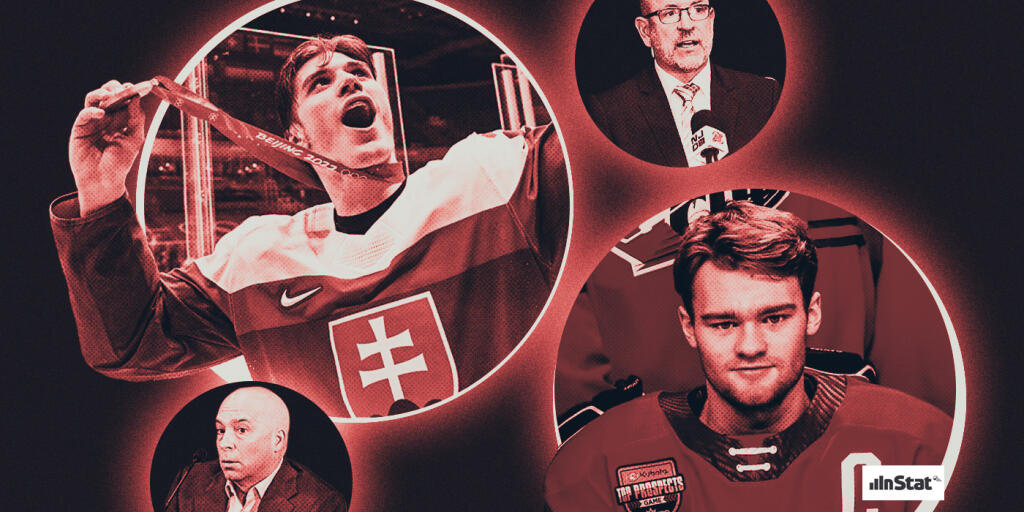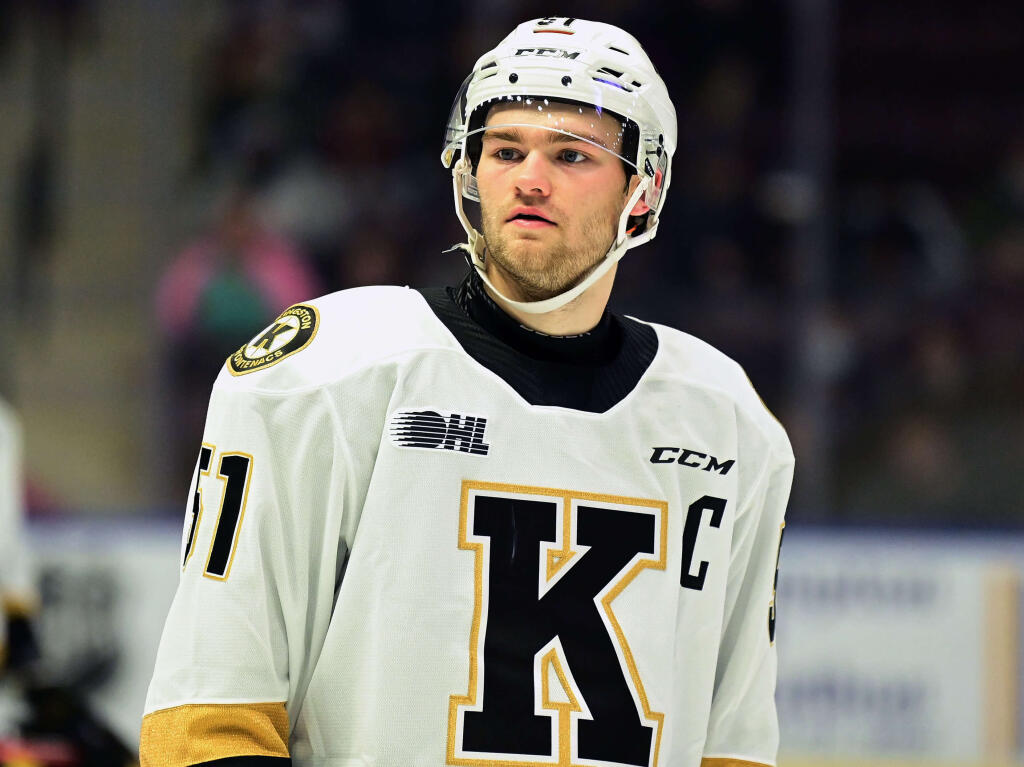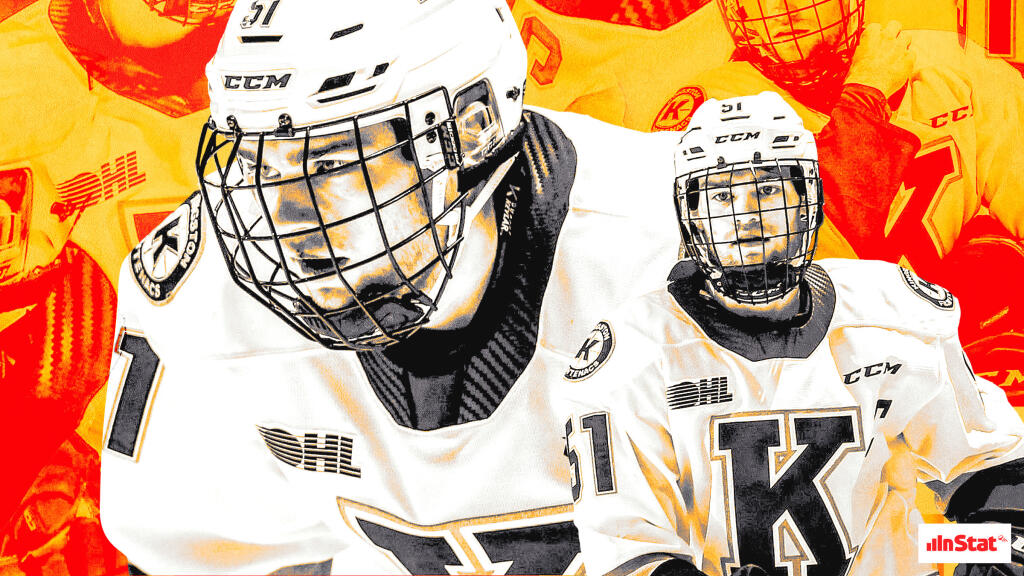Shane Wright or Juraj Slafkovský: What should the Montréal Canadiens do with the first overall pick

When the Montréal Canadiens won the top overall pick in the 2022 NHL Draft Lottery, their fans probably thought that they received the certainty of an elite prospect, someone that would become a core piece of their formation and one of its building blocks, but what they inherited instead was an obsessive debate that would haunt them for weeks.
Shane Wright or Juraj Slafkovský?
The No. 1 pick is a gift if you can accept the suspense that comes with it.
Awaiting the choice of the organization is hard, but it's even more difficult to be on the Canadiens' side. This is a selection that will come to define the team. There is a lot of pressure on the management group and no generational player to save them from having to make a choice.
It's impossible to know the future; there is only so much they can predict and control. It's more likely than not, considering the smaller than usual talent separation at the of the class, that the first overall pick will end up a great player, but not necessarily the best to come out of the draft.
That best player might be drafted at the 15th overall slot, the 37th, or the second one.
And that's OK.
The job of the Habs is to pick the player who has the best chance of becoming the best player in five years, based on the information they have now. If they really follow an exhaustive scouting process and develop the chosen player to the best of their ability, there won't be any place for regret.
Below, we compare Wright and Slafkovsky, the two most prominent contenders for the top spot, and explain the choice for that spot at Elite Prospects and EP Rinkside.
Performance analysis
As of now, most of the discourse around these prospects and their ranking has been centered around their performance this season: Slafkovsky's ability to take charge on the International stage, his low production in Liiga, and Wright's own numbers in the OHL, his reputation and lack of intensity.
A prospect's performance is important. It speaks to his makeup and character and it also holds predictive value. Draft year numbers are usually a good indication of upside.
While in most cohort predictive models, Wright comes out significantly ahead of Slafkovsky, due to his higher scoring numbers in his main league, Slafkovsky also put up a strong production against close-to NHL talents in a decent sample of games on the International stage. These games can't be ignored when projecting him.
When evaluating a prospect's performance, be it through straight numbers, NHLe, or on more subjective metrics, context matters.
There is a flurry of factors that can affect the measures and our perception of performance, making it seem worse or better than it actually is. A player's numbers, pace, intensity, and even creativity depend a lot on his environment, their system, teammates, and opposition.
Some players flash because they can.
Logan Cooley, for example, played in an incredibly permissive system this year with all-star teammates against weaker competition. He could try every play in the book without being punished.
Some players are restricted by their environment.
Wright's team had a more collective focus. They played a football-like game that was based on a lot of short passes. Wright, being the leader-by-example that he is, might have adapted his game to that system, something that could have reduced his scoring totals and made him seem like less of a carry-type forward.
And some players go through ups and downs due to a change in environment.
Slafkovsky didn't perform in Liiga in a more strict system where he got fewer minutes and puck touches. But he was used as a puck transporter at the IIHF World Championships and got the runways to pick up speed, ice-time, a high volume of puck touches and the support of at least one NHL-calibre teammate. He was able to deliver impressive performances.
We can only imagine how each prospect would have performed in each other's circumstances.
Would Wright have scored at close-to-record totals in the USNTDP? Would he have earned more minutes than Slafkovsky in Liiga and, in turn, produced more than him? Would Slafkovsky have scored more than Wright in Kingston?
It's hard to know, but these are all scenarios one has to think about when ranking players with vastly different contexts like Wright and Slafkosvky.
In that same vein, a quote grabbed my attention when I read Bob McKenzie's final ranking and article on the draft.
''Wright has not played with the vigour or passion to score as he has in years past,'' said a fifth scout, who feels Wright could solidify No. 1 if he rediscovers his game. ''If he plays the way he did (at the U18) in Texas last year, he'll run away with the No. 1.''
Contrary to the scout quoted above, I wasn't all that impressed by Wright's performance at the U18 World Championships last season. He didn't seem to dominate. To me, he was the same Wright, a player who connects plays, finds open ice, and finishes scoring chances, but who doesn't flash high-end skills as often as other top prospects in this draft.
I was surprised when I went back to see his production: 14 points in 5 games. These numbers suggest that Wright dominated the tournament as an underage forward.
Maybe my evaluation of his performance at the time was wrong.
His production could also have been boosted by his environment. Wright was playing in a different system with a higher quality of players than he faced. He also took advantage of some weaker formations.
Maybe his passion for scoring wasn't higher then. Maybe it was the same as it is now but the puck just went in more at the time. He was luckier and set up for success.
Numbers have a way of shaping a narrative, and in small sample sizes, they can sometimes lead you to the wrong conclusions. It's also why one can only give some much weight to Juraj Slafkovsky's tournament performances.
With the information we have, when strictly evaluating performance, if one values consistency of production, Wright comes out ahead of Slafkovsky with his close-to 1.5 point-per-game OHL production.
If one values a player's ability to step up when it counts, Slafkovsky wins out. His seven goals at the Olympics, seven points in 18 games in the Liiga playoffs, and his nine points in eight games at the World Championship seem of more importance than Wright's own 14 points in 11 OHL playoff games.
On the subjective intensity and highlight-reel plays per 60 minutes scales, it's also Slafkovsky over Wright. The Slovak winger was definitely more assertive and flashy than Wright in his draft year. He took charge and imposed himself on the biggest stages more often.
On the more advanced statistical measures, the micro tracking stats, Wright likely beats Slafkovsky. We only have the winger's Liiga measures to use as a potential comparison, not his international ones, but as Wright has one of the best profiles ever on Mitch Brown's data set, with close-to-perfect scores on the offensive and transition metric, it's hard to envision that Slafkovsky's underlying numbers were better this season.
Overall, again, on strict performance analysis, both players seem relatively equal, with arguments on both sides that tend to even themselves out in the end.
Compared to expectations, Wright underperformed and Slafkovsky overperformed. Those expectations matter, but they don't have a bearing on the ranking of both players as it's hard to frame their impact.
It's best to resist the temptation to grade a player more harshly because of his reputation or more positively because of his late rise. As of today, no study that I know of has managed to show, without a doubt, that it's better to favor late-risers at the draft.
I wrote about draft biases, Wright's career arc, the season of development he missed, and the burden of being the anointed best player in this draft years in advance in this article a few months ago.
Projection analysis
The evaluation of these two prospects can't stop at their play and numbers in their draft year, as top-end prospects, especially, evolve to stay or move ahead of their competition as they mature.
Projection matters more than performance. It's more valuable to compare Wright and Slafkovsky, not on their current results, but on what their play will look like in five years, at the peak of their respective career.
We can't know the future, but we can forecast it based on a few elements, like a prospect's skills and the expected development of those skills (something we can predict from the improvements of past prospects).
All the skill grades we give out at Elite Prospects are projections. They're an indication of how good skill will be in a few years, after development, compared to an average NHL player, if the prospect reaches his realistic upside.
Five is an average grade; nine, an elite one.
As you can see, we project that almost all the skills of Wright and Slafkovsky will be above-average at their peak. Those skill grades also have an equal average. If we give a bit more weight to the hockey sense mark, which seems fair, as it's the most important skill — a player's awareness, processing, and anticipation is the foundation of his game — Shane Wright comes out ahead, slightly.
This is an early indication that, based on the view of our scouts, Wright has a higher upside.
This answer doesn't feel very satisfying, however, as the separation is slim and a few skill grades don't necessarily capture the essence of a player's game.
Wright and Slafkovsky are vastly different players. The best way to level the playing field and separate them is to go one step further and project not only their skills but their future impact on the different facets of the NHL game, their ability to make plays in all three zones, support teammates, win battles, finish scoring chances and to defend.
Defence
Wright
The most recurring criticism of Wright's play is his low intensity, his tendency on the backcheck and forecheck to lower his stride rate when not immediately involved in the play. That facet of his game rightfully annoyed some scouts this season, who wanted Wright to aggressively pursue the puck.
The center plays at a pace that maximizes his space. His game is based on controlling his speed and arriving at the right time, at the right place. Quite often this season, he avoided overpressuring the opposition, as doing so could leave other attackers free of coverage and/or congest certain areas of the ice, something that makes breakouts harder, as it limits passing options when a team gets the puck back.
When he does join the NHL, Wright will have to find a balance between anticipating the game and pressuring the opposition. Switching between both mindsets at the right times is what will allow him to effectively shutdown attackers.
The Canadiens shouldn't worry about Wright's ability to develop that pressure game, however.
Many, if not most, top prospects significantly improve their motor as they rise up in level. They increase their pace to match the demands of the league they play in. Nick Suzuki and Arthur Kaliyev, two lower-paced, recently drafted OHLers, are good examples of players who added more than a few gears to their motor to establish themselves in the NHL.
A detail-oriented, lead-by-example, athletic, and high stamina player like Wright shouldn't have any issue adapting his skating energy to the NHL. We already saw him significantly increase it in a small sample at the World Junior Under-20.
Wright with an improved motor should become at least an above-average defensive player in the NHL and even potentially a shutdown center.
Slafkovsky
Defence wasn't the main focus of Slafkovsky this season, but he seemed to care about that facet of his game. The effort was there. He got stints on the penalty kill and made a couple of impressive defensive plays on the international stage. His ability to physically engage opposing puck carrier and his long stick might give him a leg up on Wright in certain defensive situations in the NHL.
Comparison
Slafkovsky doesn't have the same knack for positioning and anticipating the game as Wright. He had trouble solving more complex defensive situations that involves more positional switches. This could remain an issue in the NHL.
Wright projects as a better defensive player. It's also likely that his defensive involvement, impact, and control will be greater considering his center role.
Winner: Wright
Playmaking - Transition and offensive zone
Wright
Wright was already playing an NHL-type transition game in the OHL, using a lot of short passes and give-and-goes to get the puck from the defensive zone to the offensive zone. His awareness, processing speed and ability to mentally map out the ice and find teammates quickly in their expected spots, should make him an efficient and effective playmaker at the NHL level.
His smart management of possession and the way he passes inside space, across the ice and back to his defenceman will allow his team to keep control of the puck and find new attack angles to break the opposition.
Wright doesn't project as someone who will create plays that aren't there on first look very often for his team, however, as his 1-on-1 skills and ability to manipulate defenders out of passing lanes aren't as developed as Slafkovsky's.
Wright has the tools, the handling , skating ability, and the occasional deception, to build a more manipulate, creative game. That being said, it's more likely that he remains a facilitator more than a creator.
Slafkovsky
Slafkovsky's playmaking game is quite different from Wright's. This season, he wanted the puck on his stick for as long as possible. He aimed to beat at least one defender, sometimes more, before passing to a teammate. Because of his fast processing and handling speed and his confidence in his own abilities, it's likely that Slafkovsky will break more defences than Wright in the NHL and generate more highlight-reel plays over his career.
But his aggressive playmaking style will have to undergo some changes inside an NHL system.
Slafkovsky's rush game looked dominant at the World Championships partly because he often got the puck in open space low in the defensive zone, not unlike a center. The runways he was given on the larger ice allowed him to accumulate speed and then move through some relatively permissive defenses, at times.
Slafkovsky won't get runways in the NHL or as much open space as a center. He will start most breakouts at a standstill on the boards or in close proximity to the defensive line across the ice, as he looks to push them back to create space for his teammate on the breakout.
Slafkovsky likely won't have the three-step burst necessary to escape NHL forecheckers with the puck in these instances. If he wants to avoid turnovers, he will have to fall back on a style of play that is closer to Wright, a quick passing one.
The winger doesn't have the same mental map of the ice or the same understanding of offensive principles and puck movements. He doesn't anticipate the position of teammates or instinctively knows the next best play as often as Wright.
That being said, it's very likely that Slafkovsky's high-level skills and ability to instantly spot gaps in coverage will allow him to develop that more efficient short-passing game over time.
Comparison
Both players could reach a similar amount of assists.
It's harder to develop the high-end manipulative abilities that Slafkovsky possesses than the give-and-go game of Wright, but Wright's current collective game is more translatable to the NHL than Slafkovsky's.
Slafkovsky is more of a solo creator, a player who beats the opposition with his straight physical and handling skills, two elements that won't be as effective against the top-end, speedy and strong, NHL opposition.
Due to his more translatable style of play, Wright has a slight edge in the playmaking category.
Winner: Wright
Off-puck offensive game
This refers to the ability of a player to position himself offensively to become an option for teammates.
Supporting teammates is what Wright does best. He understands the angle, the routes, and the speed he has to take to give the longest and easiest passing window to teammates. He doesn't overskate lanes. He knows when to keep a high position away from the play, when to let it develop, and when to act on it.
This ability should allow him to consistently get the puck in favorable conditions at the NHL level, with a bit more time and space. That time and space will allow him to find and make good next plays.
Slafkovsky is more of a creator with the puck than away from it. He hasn't shown a Wright-like ability to position away from the puck to make the plays of teammates evident and easier. He works best with teammates who can do that for him.
Winner: Wright
Physical game
The boards and the front of the net are Slafkosvky's territories. At his peak, he should be winning significantly more battles with his size, strength, and shielding techniques than Wright. Not only that, but the winger has already shown an ability to spin off of defenders to attack inside ice, a sought-after ability in the NHL.
Wright didn't shy away from board battles this season. He has the stature and the skating to learn to apply much better puck protection mechanics. It's very likely that he develops those. Many others before him did.
But it's no contest here. Slafkovsky could become one of the more fierce physical players in the NHL.
Winner: Slafkovsky
Scoring game
Slafkovsky has the more powerful and diverse arsenal of releases, but it's around the net that he will likely find more of his goals, his physical skills allowing him to slip between defenders and the goalie to screen and get his stick on rebounds.
Wright only used one shot for most of the season, a quick inside leg release that had some mechanical quirks, like an upper body that flawed back as he fired. That release is still deceptive enough to score in the NHL, although top goalies might start to read it after a little while.
It's likely that Wright will expand his arsenal of shots as many other great junior shooters did before him. And even if he doesn't, the lack of diversity in his scoring game might not matter too much, as his main scoring tool will likely be his instinct, his ability to attack pockets of space at the right time in the offensive zone to avoid checking pressure, fire off passes, and find the back of the net before goalies can cover all the angles.
Both players have 30-goal upside.
Winner: Equal
Value of role
While many NHL teams give more value to centers over wingers, this is not really an instance where this rule applies.
Yes, Wright can pivot a line, but Slafkovsky's package of skills could make him a rare asset in the NHL: a top-line power forward. It's a role that is just as much on-demand as a top-six center.
Conclusion
When projecting each player's skill and impact over the different facets of the game, Wright comes out ahead of Slafkovsky due to his greater collective play, his pass-and-reposition, NHL style of game, and potential defensive impact.
Slafkovsky will very likely generate many more highlight-reel plays and dominate the boards and the slot, but Wright should have a greater influence over the rest of the 200 feet of the ice.
It doesn't mean that all the development projections made in this article will materialize, but they were all realistic assumptions based on what we know of the game of the two prospects, what they flashed in terms of high-end NHL talents this season, and the development of other similar top prospects through the years.
Unless the character and background evaluations reveal something that significantly influences their projection, based on our read of the prospects' games this season, stats, overall performance and the projection of their skill and NHL play, if I was selecting for Montréal on draft day, Wright would be my choice.
From what we know at the moment, he has a higher upside and a higher likelihood of reaching that upside.



